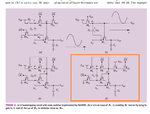bio_man
Full Member level 2
Hi,
I am using a bootstrap circuit to boost gate signal for a flying switch where Vs is not grounded. The circuit is attached. I used the same one as suggested by Razavi in his paper (https://ieeexplore.ieee.org/document/7258484/ )
I used minimum W/L sizes 1.5/0.6 (I'm using C5 CMOS technology) and CL=250pF and C=100f F for the bootstrap circuit, However, when I apply Vs=15V for testing the circuit, it seems there is something wrong. The waveforms are also attached, the main switch sees Vgs=5V across the its gate-source terminals but it is turning on fully, Vd is not the same as Vs. Any hint why this is the case? I was expecting the that transistor will turn-on fully and connect Vs to Vd
Thanks in advance,
I am using a bootstrap circuit to boost gate signal for a flying switch where Vs is not grounded. The circuit is attached. I used the same one as suggested by Razavi in his paper (https://ieeexplore.ieee.org/document/7258484/ )
I used minimum W/L sizes 1.5/0.6 (I'm using C5 CMOS technology) and CL=250pF and C=100f F for the bootstrap circuit, However, when I apply Vs=15V for testing the circuit, it seems there is something wrong. The waveforms are also attached, the main switch sees Vgs=5V across the its gate-source terminals but it is turning on fully, Vd is not the same as Vs. Any hint why this is the case? I was expecting the that transistor will turn-on fully and connect Vs to Vd
Thanks in advance,


